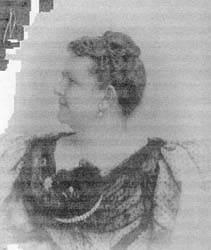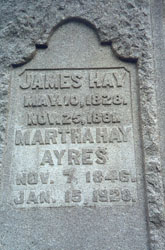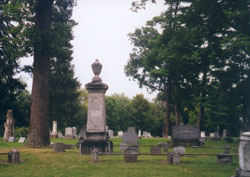
Home
- Artifacts
- Buildings & Businesses
- Churches
- Holidays & Celebrations
- Counties/Locations
- Delta College
- Early Settlers
- Ethnic Background
- Local, Michigan, U.S. and World Events
- Family Genealogy
- Farming
- Libraries & Museums
- Local Sites
- Logging
- Musicians, Artists & Famous People
- Nature, Weather & Four Seasons
- Railroads
- Schools
- Sports
 |
I became interested in Martha Hay because she was an outstanding woman from Saginaw, and because I wanted to discover why she was so important in the 1800s, during the lumber baron days. I looked through many different books, newspaper clippings, and other resources, and I quickly started to notice that not only was she an important women for her time, but she was very wealthy also. Martha Amy Hawkins was born in the village of Dixboro, Michigan, near Ann Arbor, on November 7, 1847. Her parents were Jabez Hawkins and Mary Doyle. Her mother was from Ohio and her father was from Vermont (Looby).
Martha married very young, at age seventeen. However, back in the 1800s, it was considered normal to marry at that age. On December 13, 1864, Martha Amy Hawkins married James H. Hay in Detroit, Michigan. James was thirty-six years old. I am eighteen, and I really do not think my parents would be too pleased if I wanted to marry a thirty-seven year old right now. (Even if he were as wealthy as James was, I still don't believe my parents would feel it was appropriate!) Martha’s husband, James Hay, was born May 10 1828, in Scotland. His family later moved to Warwick, Canada, to farm. James was the third of seven sons, and he was always by his fathers' side, helping with whatever needed to be done.
James ended up coming to Michigan at age twenty-one and worked in St. Clair for two years for various lumber firms. A short while after that, in 1859, James began a partnership with Erza Rust. The name of their business was called Rust & Hay. Lumber barons Rust and Hay proceeded to produce ten million board feet (on average quantity) of logs each year. They were very successful. In 1863 Mr. Hay was elected by the board of Directors to be President of the Tittabawassee Boom Company. James held this position until he died from an attack of congestion of the lungs on November 26, 1881. James H. Hay was a very well-known business man of Saginaw; he was respected and honored by many, as the highly respected President of the Tittabawassee Boom Company (Portrait and Biographical Record 369).
Martha and James lived a life of luxury. Although they were nearly twenty years apart in age, they had nine beautiful children together! Their names were James H. Hay, Mary Wetherell Hay, Will Greive Hay, Jane Hawkins Hay, Martha Doyle Hay, Alice Merrill Hay, Ethel Rust Hay, Blanche Palmer Hay, and Nina James Hay (Looby). The Hay family lived in a breathtaking three-story mansion on 400 Washington, which would now be located at 400 S. Michigan. The average mansion in the 1800s had twelve to sixteen or more rooms. I couldn't imagine having a home with twelve or more rooms--that is just amazing to me. I know I would get lost if my house were as big as Martha's was! Most mansions were three stories high, like Martha's, and would have a ballroom on the top floor; this was where most special occasions would take place. The stairways curved down from the second level to the foyer, where the floor could possibly be made of marble. Mansions were not complete without horse stables and carriage barns. Also, to not have a covered area over the driveway so guests could step from their carriages right to the house was very unusual. Unfortunately, what was once a lovely piece of history no longer stands (Gross 138).
The social life of someone who was wealthy and important back in the 1800s was very busy, and parties were large and stunning. On the evening of a feast, the butler would be on duty, ready to open and assist with doors for the women arriving. The butler would also escort them to the foyer where a maid would be waiting to take coats and hats. The dining room would be filled with the lovely smell of the fine choices of foods that encircle the atmosphere. Some of the different foods would be: oysters on the half shell, pattie shells filled with chicken, turkey or pheasant, cranberry jelly, sweet and white potatoes, squash, pickled peaches, and a wide selection of the finest wines. The main entree might be a fine choice of either rump roast or venison. Dessert could be a difficult decision: fruit pudding with hard sauce or ice cream, followed bye coffee with nuts (Gross 139). Wow! I am sure that would be one fulfilling meal.
 |
The Hays were also very involved in their local First Presbyterian Church. Martha was listed as a charter member of the First Presbyterian's Foreign Missionary Society in Saginaw. Back then it was expected--especially if you were a person of that standing in the community—that you would attend church (Looby Green Gold).
When James Hay died on November 25, 1881, Martha willingly took over her husband’s sawmill and was one of only two females known to have become a lumber baron at that time. She became a member of the Tittabawassee Boom Company monopoly, and was the only woman in this all male club. I really admired that fact about Martha, because at that time women were not even allowed to vote. Therefore, for her to take over a position of such power in an all-male monopoly was just amazing! Martha was very active in the affairs that went on is Saginaw, and she also registered three log marks in her own name.
In 1896, fifteen years after the death of James, Martha married Ebenezer R. Ayres. Unfortunately, this was all the information I found on Mr. Ayres at this time.
 |
Martha Amy Hawkins Hay Ayres died Sunday, January 15, 1928, in St. Louis, Missouri, at her daughter Jane Cumming's house. Martha broke her hip in May when she went to visit her daughter and never fully recovered. The combination of a broken hip and old age caught up with Martha fast. She was eighty-one years old when she died. She is buried with her other family members in the Hay Plot at Oakwood Cemetery, in Saginaw ("Pioneer Resident" 10).
Martha's last Will and testimony is very interesting to read, even though it is quite extensive. Some items that I found she put into the utmost detail are as follows: "one, small tea pot, green and gold; one, small vase with handle, flower decorated in pink and brown; and one, glass vase, reddish color with blue, round bottom, small top, diagonal narrow stripes". There were many more pages of the will that went on in exactly that kind of detail. Some items even had numbers on the bottom of them to tell which ones went to which persons. Martha also had a lot on Higgins Lake in Roscommon County, the lot number was ten (Looby Green Gold).
Martha lived a long, prosperous, and happy life! She married young but turned into a responsible woman fast! Martha Hay Ayres was one remarkable woman and a wonderful role model for women and even men of the 1800s. She also had a spectacular life with a wonderful marriage, wealth, children, a beautiful mansion, recognition, popularity and respect from society in Saginaw. I think it would have been quite a pleasure to have known or even met Martha in the 1800s, and I am sure the citizens of Michigan will not forget Martha Hay Ayres for a very long time!
Works Cited
- Gross, Stuart. Frankie and the Barons. Fowlerville, MI: Wilderness, 1991.
- Looby, Mary Beth. "Fact sheet on Martha Hay." Martha A. Hay Vertical File. Saginaw, MI: Hoyt Library Eddy Historical and Genealogical Collection, 2002.
- - - -. Green Gold Rush. C.D. University Center, MI: Delta College, 2002.
- "Pioneer Resident, Mrs. Ayres Dead." The Saginaw Daily News. 17 Jan. 1928: 10.
- Portrait and Biographical Record. Chicago: Biographical Pub. Co., 1892.
| The written and visual works in Mid-Michigan Remembers-Stories about Us were chosen on the basis of their quality, diversity, community interest and appeal. Views expressed do not necessarily reflect those of the College. This space is provided as a service by Delta College. |